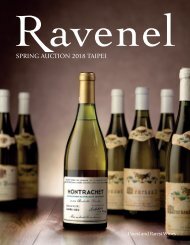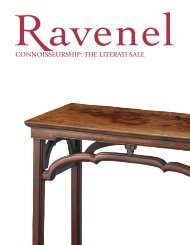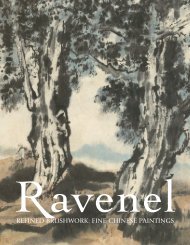亞洲現代與當代藝術 Modern and Contemporary Asian Art
羅芙奧2018春季拍賣會 亞洲現代與當代藝術 Ravenel Spring Auction 2018 Modern and Contemporary Asian Art
羅芙奧2018春季拍賣會 亞洲現代與當代藝術 Ravenel Spring Auction 2018 Modern and Contemporary Asian Art
You also want an ePaper? Increase the reach of your titles
YUMPU automatically turns print PDFs into web optimized ePapers that Google loves.
THE ADVENTURE LEADS TO A RIVERSIDE,<br />
A NEW SCENE WITHOUT BOUNDS.<br />
WAITING TO MEET THE EASTERN WINDS,<br />
SPRING IS ALWAYS IN THOUSANDS OF VIOLETS AND REDS.<br />
- A Spring Day. (Song) Zhu Xi<br />
BEYOND THE IMAGE<br />
In the words of Wu Dayu, "To create a painting dem<strong>and</strong>s complete<br />
sincerity. It's not something to get smart about or show off, since it<br />
might take six years of schooling before you're able to even make a<br />
single finished, agreeable painting." Such a philosophy of painting<br />
was adopted as the main idea <strong>and</strong> st<strong>and</strong>ard of practice by Chu Teh-<br />
Chun, one of the abstract artists in modern Chinese art. A lover<br />
of Western classical music, Chu Teh-Chun would listen to it while<br />
working as a way to ignite another side of himself. He would follow<br />
the music's mild, 'yin <strong>and</strong> yang' transitions, drawing inspiration from<br />
the depths, heights, <strong>and</strong> countless undulations, adding detail <strong>and</strong><br />
a sense of delicate, musical rhythm to his abstract paintings. With<br />
the light strokes of Chu Teh-Chun's heavy brush, ink is gracefully<br />
blended using both Chinese <strong>and</strong> Western techniques, theories,<br />
<strong>and</strong> expressions. The brushstrokes rise <strong>and</strong> fall across the paintings<br />
like a dancer, stepping, lunging, <strong>and</strong> leaping across a stage. There<br />
is a clear sense of action on the canvas, with colours colliding <strong>and</strong><br />
interweaving as if shifting through every season at once. Together,<br />
they give structure to the multitude of galaxies <strong>and</strong> l<strong>and</strong>scapes<br />
without end in the artist's imagination.<br />
Having hiked mountains <strong>and</strong> walked rivers thous<strong>and</strong>s of times<br />
during his travels in different countries, what Chu Teh-Chun saw<br />
<strong>and</strong> where he stepped he took to heart, later adapting those<br />
colours into the bright forms of his work. One can see in Chu Teh-<br />
Chun's abstract paintings how the artist had developed techniques<br />
in calligraphy since his childhood. The artist's masterful infusion<br />
of the spirit behind Chinese l<strong>and</strong>scape painting with a natural <strong>and</strong><br />
flowing script gives the work a certain connection to ink painting.<br />
While a thick brush sweeps through the majestic mountain ranges,<br />
a fine brush flies with the electricity in the wind, <strong>and</strong> together they<br />
cover the canvas in a captivating Eastern texture of colourful oils<br />
<strong>and</strong> drunken inks that only Chu Teh-Chun could do. But beyond<br />
the technical side of the work which would pose a challenge for<br />
Western artists, even more difficult to replicate is the vibrant,<br />
scenery-transcending energy of the paintings.<br />
Chu Teh-Chun was a master of his craft, <strong>and</strong> he considered nature<br />
to be the main fountainhead of his creative inspiration. The most<br />
beautiful l<strong>and</strong>scapes <strong>and</strong> gorgeous scenes he had seen would<br />
transform before his eyes into nourishment – the winter snow,<br />
summer rain, spring flowers, <strong>and</strong> autumn leaves that all made marks<br />
on his art practice. Oxford University art critic Michael Sullivan,<br />
who was previously a Tang dynasty literature critic, once described<br />
the paintings <strong>and</strong> artistic wisdom of Chu Teh-Chun in the terms<br />
of Sikong Tu as written in Quality of Gr<strong>and</strong>eur in Poetry: 'Leap<br />
beyond the external appearance to reach the centre of the circle'.<br />
While originally describing the cathartic peak of a poem, it is also<br />
extremely befitting of Chu Teh-Chun's beautiful paintings. Taking<br />
a look at this 1995 "untitled" work, one can make out the artist's<br />
passion for the techniques of Eastern calligraphy <strong>and</strong> his applied<br />
knowledge of Western<br />
colour palettes as they<br />
are hidden throughout<br />
the painting. Yet even<br />
more recognisable is Chu<br />
Teh-Chun's refinement<br />
of ink painting skills such<br />
as "heaviness, lightness,<br />
dryness, waterlessness,<br />
moistness, droughtiness,<br />
smudginess" through the<br />
vocabulary of Western<br />
oil painting, adding<br />
soft yet robust layers<br />
of delicate yet bold<br />
details. The endlessly<br />
glimmering brilliance of<br />
the colours leads viewers<br />
into the artist's romantic<br />
world, which is filled with<br />
scenes that resonate with<br />
audiences' memories of<br />
nature, ever so gently<br />
pulling them closer.<br />
<br />
Northern Song Dynasty, Li Cheng, A Solitary Temple Amid Clearing Peaks, color on silk,<br />
111.4 x 56cm, Collection of The Nelson-Atkins Museum of <strong>Art</strong>, Kansas, USA







